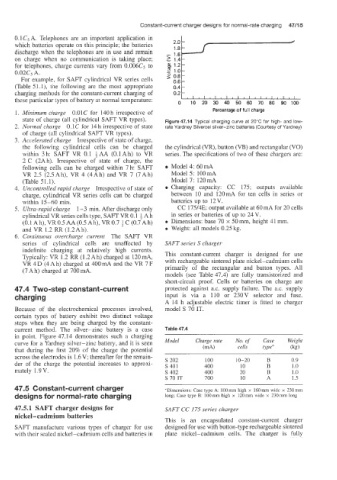Page 482 - Battery Reference Book
P. 482
Constant-current charger designs for normal-rate charging 47/15
0. IC5 A. Telephones are an important application in
which batterief, operate on this principle; the batteries 2.0
1.8
discharge when the telephones are in use and remain
on charge when no communication is taking place; I
2 1.4
for telephones, charge currents vary from 0.006C5 to 8 1.2
0.02C5 A. c 1.0
For example, for SAFT cylindrical VR series cells 9 0.8
0.6
(Table 5 1. l), tne following are the most appropriate 0.4
charging methods for the constant-current charging of 0.2
these particular types of battery at normal temperature:
0 10 20 30 40 50 60 70 80 90 100
1. Minimum charge 0.01C for 140h irrespective of Percentage of full charge
state of charge (all cylindrical SAFT VR types). Figure 47.14 Typical charging curve at 20°C for high- and low-
2. Normal charge 0.1 C for 10 h irrespective of state rate Yardney Silvercel silver-zinc batteries (Courtesy of Yardney)
of charge (all cylindrical SAFT VR types).
3. Accelerated charge Irrespective of state of charge,
the following cylindrical cells can be charged the cylindrical (VR), button (VB) and rectangular (VO)
within 3h: SAFT VR 0.1 SAA (0.1Ah) to VR series. The specifications of two of these chargers are:
2 C (2Ah). Irrespective of state of charge, the
following cells can be charged within 7 h: SAFT 0 Model 4: 60mA
VR 2.5 (2.5Ah), VR 4 (4Ah) and VR 7 (7Ah) Model 5: 100mA
(Table 51.1). Model 7: 120mA
4. Uncontrolled rapid charge Irrespective of state of 0 Charging capacity: CC 175; outputs available
charge, cylindrical VR series cells can be charged between 10 and 120mA for ten cells in series or
within 15-60 min. batteries up to 12V.
5. Ultra-rapid charge 1-3 min. After discharge only CC 175/4E; output available at 60 mA for 20 cells
cylindrical VR series cells type, SAFT VR 0.1 4 Ah in series or batteries of up to 24V.
(0.1 Ah), VR 0.5 AA (0.5 Ah), VR 0.7 f C (0.7 Ah) 0 Dimensions: base 70 x 50m, height 41 mm.
and VR 1.2 RR (1.2Ah). 0 Weight: all models 0.25 kg.
6. Continuous overcharge current The SAFT VR
series of cylindrical cells are unaffected by SAFT series S charger
indefinite charging at relatively high currents.
Typically: VR 1.2 RR (1.2A h) charged at 120 mA, This constant-current charger is designed for use
VR 4 D (4 Ah) charged at 400 mA and the VR 7 F with rechargeable sintered plate nickel-cadmium cells
(7 Ah) charged at 700 mA. primarily of the rectangular and button types. All
models (see Table 47.4) are fully transistorized and
short-circuit proof. Cells or batteries on charge are
Two-step constant-current protected against a.c. supply failure. The a.c. supply
input is via a 110 or 230V selector and fuse.
A 14 h adjustable electric timer is fitted to charger
Because of the electrochemical processes involved, model S 70 IT.
certain types of battery exhibit two distinct voltage
steps when they are being charged by the constant-
current method. The silver-zinc battery is a case Table 47.4
in point. Figure 47.14 demonstrates such a charging
curve for a Yardney silver-zinc battery, and it is seen Model Charge rate No. of Case Weight
that during the first 20% of the charge the potential (d) cells type* (kg)
across the electrodes is 1.6 V; thereafter for the remain- s 202 100 B 0.9
der of the charge the potential increases to approxi- S 401 400 10-20 B 1 .O
10
mately 1.9 V. S 402 400 20 B 1 .o
S 70 IT 700 10 A 1.5
47.5 Constant-current charger *Dimensions: Case type A: lOOmm high x 160mm wide x 230mm
designs for normal-rate charging long; Case type B: lOOmm high x 120mm wide x 230mm long
47.5.1 SAFT charger designs for SAFT CC I75 series charger
nickel-cadmium batteries
This is an encapsulated constant-current charger
SAFT manufacture various types of charger for use designed for use with button-type rechargeable sintered
with their sealed nickel-cadmium cells and batteries in plate nickel-cadmium cells. The charger is fully

